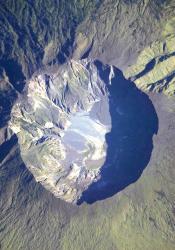The 1815 Eruption of Mount Tambora
Mount Tambora is a stratovolcano in Indonesia, and although it is still active today this post will focus on its infamous eruption in 1815. When Mount Tambora blew up in 1815 it "blasted 12 cubic miles of gases, dust and rock into the atmosphere and onto the island of Sumbawa and the surrounding area" (Evans) and became one of the largest eruptions in the previous 10,000 years. Approximately 10,000 civilians died immediately following the eruption and 90,000 in total. This eruption resulted in the following year being coined "The Year Without Summer", although it lasted for a 3 year period. The climate more thatn 7,000 miles away from the eruption was heavily affected. The debris from the eruption changed the weather to be much colder than it normally was, diseases started surfacing, and people generally felt off mentally, simply from everything changing so drastically. People during this time period relied heavily on the success of their crops, most were living from harvest to harvest. When crops would fail many people would become desparate for any kind of food. The 3-6 degree Farenheit change in weather and changes in precipitation effected many individuals mentally making this time period a popular time for Gothic stories to emerge.
Mary Shelley is one of the authors during this time period that reflected real life events into her writing, specifically in her novel Frankenstein. She started writing the novel in 1816, the "Year Without Summer" and the first edition was eventually published in 1818 when the weather went back to normal. The connection between the weather she was experiencing and the setting of her novel is no coincidence. When she was abroad in Europe, Shelley wrote many letters to her half-sister, Fanny Imlay, about the peculiar weather they were experiencing. She recorded in one of her letters that "'One night we enjoyed a finer storm than I had ever before beheld. The lake was lit up—the pines on Jura made visible, and all the scene illuminated for an instant, when a pitchy blackness succeeded, and the thunder came in frightful bursts over our heads amid the blackness'" (Wood). Scenes of gloomy and dark weather in Frankenstein echo the weather she was experiencing herself.
Since people at this time were experiencing hunger at a level many will never understand, there was a slew of beggars and those experiencing poverty. When Shelley describes the creature in Frankenstein to appear almost zombie-like. Shelley forms the creature in her novel to "[bear] the mark of the famished and diseased European population by which she was surrounded in 1816-18" (Wood). She most likely saw so many people who were shuffling around different towns in search for food, or warmth. These people were also perceived as a disruption to the civilized part of society. Just as these suffering people were seen as wanderers and potential threats to those who were civilized, so was the creature. Shelley's ability to take her experiences of the aftermath of the eruption and turn it into such a creative novel is incredible to me. She was recording evidence of history without even realizing it.
Works Cited
Evans, Robert. “Blast from the Past.” Smithsonian.com, Smithsonian Institution, 1 July 2002, https://www.smithsonianmag.com/history/blast-from-the-past-65102374/.
Wood, Gillen D’Arcy. “1816, The Year without a Summer.” BRANCH: Britain, Representation and Nineteenth-Century History. Ed. Dino Franco Felluga. Extension of Romanticism and Victorianism on the Net. Web. 30 March 2022.

